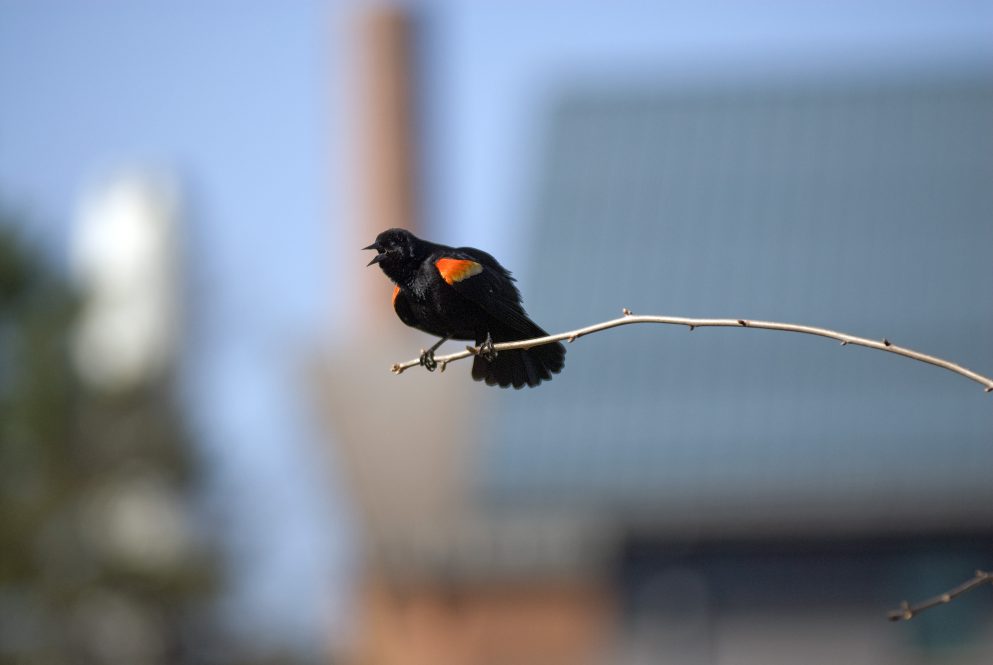Songbirds in the eastern part of the United States are getting sick with crusty eyes and neurological issues, but no one knows why. The Connecticut Department of Energy and Environmental Protection (DEEP) is tracking and managing a new disease affecting songbirds in collaboration with the Connecticut Veterinary Medical Diagnostic Laboratory (CVMDL) in the Department of Pathobiology and Veterinary Science at UConn’s College of Agriculture, Health and Natural Resources.
Songbirds are an attractive feature of our Connecticut landscape for many residents. Robins, finches, cardinals, sparrows, ravens, orioles, and chickadees are a few of the many songbird species that we see and hear. Birds infected with the new sickness have crusty eyes or discharge and neurological issues including loss of balance, seizures, and head shaking.
Many states have confirmed cases of this new songbird disease and the sickness is progressively moving toward New England. There is much that is unknown about this songbird disease and that is why CVMDL is collaborating with DEEP to provide diagnostic testing services and pathology. CVMDL has been a driver of disease investigation and discovery with its collaborative partners by offering high-quality, accurate, and fast diagnostics and pathology.
Diagnostic Testing
“The great mystery is how a disease like this happens, we don’t know exactly what causes it,” says Jenny Dickson, Director of the Wildlife Division at DEEP. “One of the great challenges with the songbird sickness is that the symptoms are similar to other diseases we see at this time of year, for example, the conjunctivitis with Finch Eye Disease. We’re also starting to see West Nile Virus in birds at this time of year and West Nile causes balance issues. When someone reports a sick bird with either conjunctivitis or balance issues, many will think of Finch Eye Disease or West Nile Virus first. What’s different this time is the combination of symptoms, the eye infection and balance issues.”
CVMDL is an independent diagnostic laboratory accredited by the American Association of Veterinary Laboratory Diagnosticians, aligned with UConn, which supports other state agencies, the federal government, veterinarians and the public. The laboratory’s role is supporting essential functions in disease diagnosis and research. Pathology done at CVMDL helps track transmissible diseases, maintain animal health, and protects the public.
“DEEP manages the wildlife; we have a role getting them the information they need to contribute to a greater knowledge in support of that management,” says Salvatore Frasca Jr., Director of CVMDL. “Our role is to support them with investigative reports on animal and zoonotic diseases. The relationship with DEEP is exemplary. We provide them with high-quality diagnostic services that mesh with their needs. We work one-on-one to apply or develop the diagnostics they need for each particular case to best help each other accomplish our goal of managing disease.”
Working with CVMDL helps DEEP find more information about the disease. DEEP is currently collecting data, and CVMDL is running tests to see if they can determine the cause of the songbird illness.
“Our goal is to add to the regional data set and work collaboratively to find solutions,” Dickson says. “We are paying close attention to the data sets collected in other states. We rely on the expertise of CVMDL because they have services that aren’t available at other diagnostic locations. We’re working with the faculty at CVMDL to determine what makes the most sense to test. We’re asking how what we test informs the broader science.”
DEEP submits songbirds or biological samples to CVMDL for testing, providing the history of the specimen to the laboratory so the testing can contribute to the greater understanding of the disease. This process allows DEEP to manage and mitigate risks while improving wildlife stewardship.
“The strategy with the songbird and other diseases is to attend to the issue, and then it becomes part of the structure of how wildlife is managed,” Frasca says. “Our work will also drive future research that we’ll participate in as the disease becomes something we recognize and manage with DEEP. Other songbird issues in the past, for example, salmonellosis, have affected populations and are managed by DEEP.”
Citizen Science: How Connecticut Residents Can Help
Citizens can take several steps if they find a bird with a crusty eye and discharge or one that is easy to catch. First, DEEP wants you to catch the bird and put it in a cardboard box and contact a wildlife rehabilitator. The birds receive treatment and further testing is done on biological samples to help understand the disease. Rehabilitated birds are released back into the wild. Any deceased birds should be reported online. If the sample is still relatively fresh, keep it cool, and report it to DEEP so that DEEP can arrange with the CVMDL to have tests run.
“People are concerned when we ask them to take in their feeders,” Dickson says. “We’ve learned a lot through all the other disease studies and have found that being proactive makes good conservation sense and helps protect the birds. There are lots of natural food sources available right now, it’s not unlike what we ask people to do with social distancing, we’re trying to break the disease cycle.”
Connecticut, Massachusetts, Rhode Island, and New Hampshire have all taken proactive approaches to addressing the songbird disease. New York has a different approach, but Connecticut chose to be more proactive because of DEEP’s previous work with CVMDL on projects such as white nose syndrome in bats and West Nile Virus. These cases have shown that being proactive is better for the wildlife.
CVMDL has a rich history of working with DEEP on wildlife investigations. They have also partnered on scholarly pursuits with CVMDL to continue informing science. “The beauty of our partnership with CVMDL is that its taught us a lot about how to respond to emerging wildlife diseases,” Dickson says.
More information can be found at s.uconn.edu/songbirds and https://cvmdl.uconn.edu/.



